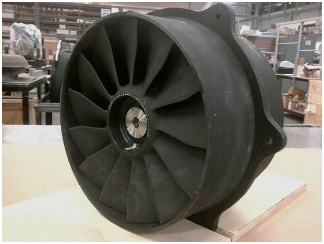A US based defence contractor, an original equipment manufacturer (OEM) of life support systems (LSS) for military applications, had a requirement for a custom fan to be integrated into its product line. With TURBOdesign1, the company was able to bring the fan design process in-house and reduce design time as well as production cost.
In developing the fan, engineers were challenged to develop a large air-flow-volume, low-pressure fan characteristic with high air velocities over the stator blades. In order to achieve the best aerodynamic efficiency, it needed to avoid separation at the stator while recovering the static pressure. No existing standard design was available to satisfy the requirements for efficiency, size, and operating speed.

Figure 1. The resulting geometry of one of the axial flow stages designed by TURBOdesign1.
Initially, the company evaluated several conventional fan design approaches, including all the available commercial codes for design of turbomachinery based on a direct design approach. The evaluation criteria included computer system requirements and associated hardware costs, the number of engineers needed to be involved in the design process, and the learning curve to produce new designs with a high level of confidence.

Figure 2. The final hardware model.
TURBOdesign1 software came out the winner, partly because it did not require special hardware and, after just three weeks of initial training, engineers were able to tackle their first fan design case. The design team used the 3D inverse design code to introduce these new features and achieve rotor blade loading that produces the required flow and pressure rise at the lowest shaft power with a sufficient stall margin. TURBOdesign1 inverse design code used together with CD Adapco Star CCM+ computational fluid dynamics (CFD) software, has proven to satisfy all of the new design objectives.
After completing and testing two different axial fan designs, the company engineers became more confident that their next designs would be successful. Examples of the resulting geometries of the stage are shown in Figures 1 and 2.
"We found ourselves using all the features implemented in the TURBOdesign1 code," said the company's aerodynamics engineer. "In addition to specifying meridional geometry and blade loading, having the ability to specify custom blade thickness, stacking location, and stacking profiles were very useful in achieving good aerodynamic designs."
The use of TURBOdesign1 software made it possible to design an entirely new cooling fan from scratch, starting only from design requirements. In the process, the company was able to eliminate the costs of using outside consultants, reduce the lead time for new turbomachinery designs of this type, and produce its own designs in-house that are best suited to its application needs.
"We cannot put a dollar figure on our new ability to design our own fans," said one design engineer. "But, in our opinion, it's invaluable."



Share This Post